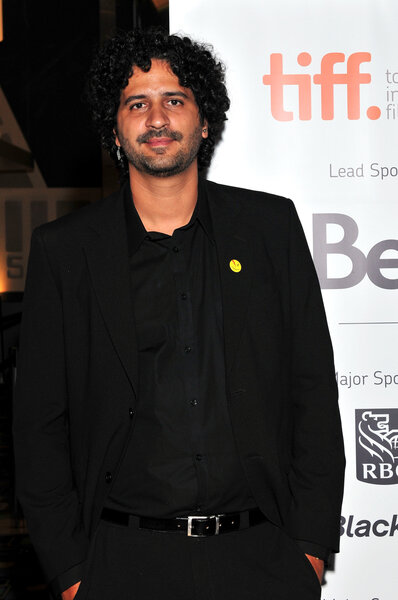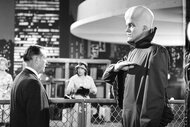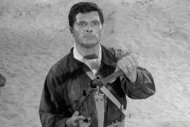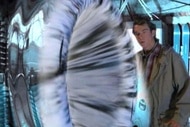Create a free profile to get unlimited access to exclusive videos, sweepstakes, and more!
Quibi’s 50 States of Fright director explains struggle of making television for smartphones
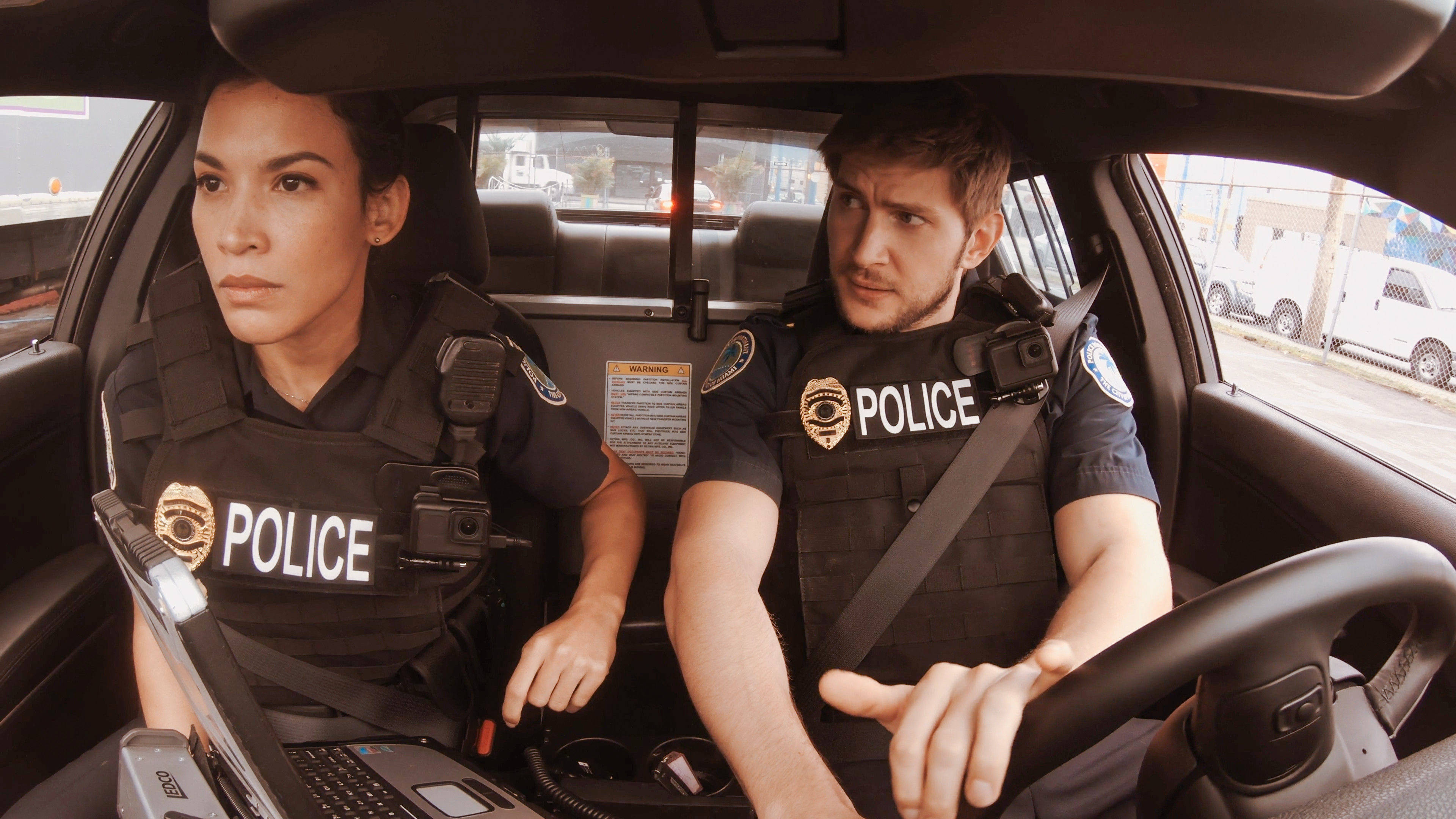
Stepping into an unknown is inherently scary. But scary is where Goya Award-winning filmmaker Alejandro Brugués (Juan of the Dead, Into the Dark’s “Pooka Lives”) works best. The horror helmer directs the Florida segment of executive producer Sam Raimi’s spooky United States-spanning Quibi series, 50 States of Fright, “Destino.”
“Destino” takes fans to Miami thanks to a story by Eduardo Sánchez (The Blair Witch Project, V/H/S/2) and script by Gregg Hale (V/H/S/2). The found-footage story is split into three terrifying episodes that embody its state, its heritage, and its folklore’s potential for freaking everyone out. Some cops answer a call and find an escalating supernatural situation that starts off dire and only gets worse.
Brugués sat down with SYFY WIRE to discuss the episode's origins, working under the unique conditions of Quibi’s mobile platform, and how the coronavirus pandemic changes how a horror creative operates.
Tell me how you came to the project.
To 50 States of Fright? The name has changed a lot. 50 States of Fear, 50 States of Horror — I remember the crew had T-shirts with all the different titles ... Yeah, one day we got a call from Sam Raimi and Debbie Liebling, his TV producing partner, and they asked if we wanted to be part of this. Of course we said yes, and then we came up with an idea set in Florida and pitched to them, and they liked it.
Did you start with Florida in mind, or did they give you a list of states that were up for grabs?
No, we didn’t have Florida in mind, but I’m Latino, I’m Cuban. Ed Sánchez, also Cuban. We wanted to do something with a Latino angle, and seeing as we’re both Cuban, then we’re more familiar with Florida, because that’s where all Cubans go first.
The process went something like this: We decided to do something in Florida and started throwing out ideas. Ed Sánchez came up with this idea, and it made sense — because he and Gregg Hale did The Blair Witch Project, on which Gregg was a producer — to do something that was found-footage. I was the one who had never done found-footage.
Actually, when we started working on this, we weren’t sure who was going to direct it. It could be me, it could be him.
How did you guys decide who was going to direct?
Coin toss [laughs]. No, we have several projects together, and the collaboration between the three of us ... sometimes all of us are writing, sometimes one of us is writing. Right now, right before the call, I was sitting down for one of our projects because it was my turn to write.
In this one, at some point, we were like “OK, we have to figure this out.” Ed was shooting something else and I was actually shooting something else: "Pooka Lives." But my schedule was a lot more — not flexible — but it worked perfectly for this. I finished the movie one day, then they picked me up from set to go to the airport to fly to Vancouver to shoot this.
That’s a whirlwind. Especially because so much of the story is in a single location with a ton of set design.
So the thing when we wrote the story, we wanted it to be about Santería, the Cuban religion. And they saw the descriptions in the screenplay and some of the descriptions were more grounded. At some point we had stuff like ... an altar full of blood and bones. And when the Vancouver team's art department read that, they interpreted that in some way.
When we saw the designs, we were like “Holy s***! This is insane! In real life, it’s not like that, but I’m loving this so much that we’re making this movie.” It became something much bigger.
Part of working with Ed and Gregg was letting the actors improvise. I never showed the locations to the actors, because I wanted them to improvise in the scene so we could get much more footage.
When they open that door during that first episode …
When the first team goes through the first door and that thing happens at the end of the first episode, I was playing with the actors. They didn’t know what they were gonna see. They would say to me, “Are we ready for rehearsal?” and I’d say, “We’re not rehearsing this, we’re just throwing them in.” They’d say, “What about blocking?” and I’d reply, “What is there to block? They’re wearing bodycams! Let them in and see what happens.”
So during that last part of the episode, one of the two actors was really scared. You see the flashlight shaking and that was him being really afraid. I told the other one, “Get closer to him when this happens,” so there are some scares that you see that were from real life. That one was completely real.
And at the end, it was the same for the other team when they went into that room. [The] set was completely blocked from the actors. I had them come in from other doors so they didn’t see anything. They had the screenplay, but I wouldn’t say anything. I’d just say, “OK, go in and whatever happens, happens.”
I sent them to a haunted house, basically.
How was working with bodycams for the first time?
It’s a nightmare. We used GoPro, not real bodycams, because we needed to get 4K or something. But when you test the cameras, you test in a nice environment. In an office with Wi-Fi. But when we were shooting outside, the camera has such a wide lens that you can see everything. So, for exteriors, we had to be hiding one block away and we didn’t have any signal. In the building, with the different rooms, we had to be behind walls. And the signal was breaking up the whole time, so I was basically shooting blind. I was listening to the actors like, “OK, this sounds like a good take,” and then we’d check footage.
We’re using a lot of cameras and you can’t stop a shoot just to check — it kills the speed in the middle of the shoot ... I was enjoying what we were doing, but I was praying we had the material.
You have your cameras on your actors, two or three for coverage …
It wasn’t like we even had two or three, because you have to justify every camera. At some point, we were like, “I need this type of shot for this moment and we don’t have anyone wearing a camera nearby. How do we do that?”
That’s why one of the characters dies the way he dies. You had to figure out how, if anyone dies, how we can use their camera to get a good angle.
Did you have to do anything crazy to make both aspect ratios for Quibi viewers, who can watch on their phones vertically or horizontally?
We didn’t shoot it vertical. Vertical came in like, January ... we could only shoot horizontal. At some point in the process, when we were done, it turns out all the shows had done horizontal and vertical. And we were like, “OK, well, everyone else has done it.” So we had to go back and do a vertical version in post. I was very surprised by the vertical version. Obviously, I’m very pro-horizontal, but the vertical wasn’t bad.
How was doing that in post?
I was in L.A. and they were doing it in Vancouver because I was in post on [“Pooka Lives”]. They sent me a link, so I was watching them go through it in real time. He played it and tracked the vertical version, and at some point I was like, “Here, we might need to split this into two different shots” or “Can we find a way to pan from one to the other,” but the issue with that is that it takes you out of the found-footage thing. When you’re watching found footage, you know there’s no edits. Well, you can have pans from left to right if someone’s wearing a camera, but if they’re dead and they’re moving, there’s no reason why there should be that pan — or even split it in two shots because you know there’s just one camera, not two.
But when I saw it, I was like, “OK, I can live with that.” The whole thing about the vertical is that [pause] the horizontal still exists. All you have to do is tilt your hand! And you get the full thing! It’s not that hard! I’ve been watching all the others from 50 States, and I always watch it horizontal ... I know the whole Quibi thing and whatever, but we have one eye next to the other, not one on top of the other.
There was one shot in mine where, in the vertical version, you don’t get the full scope of what’s happening. When I got to that shot, I was like, “You know what? F*** it. Easter egg for the ones that can move their wrists.”
What’s been difficult about writing new stuff during the lockdown?
It’s hard to know how the world’s gonna be when we come back. What’s it gonna look like to shoot something? Is it gonna be small crews? Are we gonna have to avoid writing scenes with a lot of extras? That on one hand.
Then the content. Is this going to be something that marks us forever, or is it something we forget about in six months for the next thing? Can characters hug now? Can you put five characters inside a car or put them in a cabin in the woods? Or is everyone going to go: “No! You have to be six feet apart from each other!”
I look at my episode now and I see all those cops in their cars without wearing any masks and I’m like, “No! You’re doing it wrong!” It was the same with [“Pooka Lives!”] because in the first five minutes you have a group of friends hug each other and now I’m like, “Don’t hug, don’t hug!” Something as simple as that.
And we do horror, so there are certain things that you know we’re going to have to tackle sooner or later, like the apocalypse. We all have to deal with that when we’re doing horror, and now that we’re getting a first-hand peek at what it could be … I guess all you can do is write normally and hope things get back to normal. If not, oh well, start having all the characters wear masks and not hug each other.
Listen: It’s gonna be great for horizontal versions because you can have all the characters six feet apart, but it’ll be very challenging for the vertical version where you have to do one shot for all the characters.
50 States of Fright and all of “Destino” is out on Quibi now.
